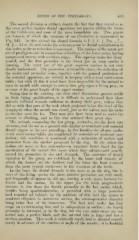Page 453 - My FlipBook
P. 453
TEETH OF THE VERTEBRATA. 463
The second division is extinct, despite the fact that they reveal to us
the most perfect laniary dental apparatus yet known within the limits
of the Carnivora, and were of the most formidable size. Two genera
are known, of which the cranium of one [Smilodon) is represented in
Fig. 243. In this animal the dental formula is I. |, C y, Pm. 2'W\,
M. ^ = 24 or 26, and marks the extreme point in dental specialization in
this order, as far as reduction is concerned. The canines of the upper jaw
are of prodigious size in comparison with those of the lower series, having
compressed crowns with serrulate edges. The superior molar has disap-
peared, and the first premolar in the lower jaw in some species is
wanting. The exact use of the great superior canines is not very
clearly understood. The possession of retractile claws, the reduction of
the molar and premolar series, together with the general perfection of
the sectorial apparatus, are strictly in keeping with a most carnivorous
habit ; but with all this it must have been impossible for the animal to
open its mouth wide enough to take a firm grip upon a living prey, on
account of the great length of the upper canines.
Seeing that in the existing cats their chief destructive powers reside
in their biting qualifications, it is difficult to understand how these
animals inflicted wounds sufficient to destroy their prey, unless they
did so with that part of the tusk which projected below the level of the
s}anpliysis when the mouth was closed, just as the walrus uses his tusks
to clamber over the ice. They may also have been used to assist the
animal in climbing, and in this way attained their great size.
The animals composing the last group, Ardoidea, are the least car-
nivorous, and do not as a general rule display as trenchant and sectorial
dental organs as the two preceding ; in two families the- almost exclu-
sively carnivorous habits are manifested by sectorials of moderate per-
fection ; this condition is associated wdth a reduction of molars and
premolars from the number possessed by the dog. In the otliers the
molars are more or less tubercular—a structure better fitted for the
mastication of the mixed diet upon which they subsist—and usually
exceed the premolars in size and strength. The extremes of dental
variation in this group are exhibited by the bears and Aveasels, of
which the former are the farthest and the latter the least removed
from the more typical carnivores in the structure of the teeth.
In the bears the dental formula is the same as in the dog, but in
most of the living species the three anterior premolars are very small,
and frequently disappear in old age, leaving a ^vide space between the
fourth and the canine. In the upper jaw the teeth progressively
increase in size from the fourth premolar to the last molar, which,
besides being quadritubercular, is provided with a large posterior
heel rounded off behind ; by the addition of this heel the crown is
rendered elliptical in transverse section, the antero-posterior diameter
being twice that of the transverse. The first true molar has four
cusps on its triturating face, and is subquadrate in outline ; the fourth
premolar is tricuspid, as in the dog, but the two outer cusps are not
united into a perfect blade, and the internal lobe is large and has a
median position. This tooth is relatively small, and is situated consid-
erably in advance of the canthus or angle of the mouth ; it is doubtful


